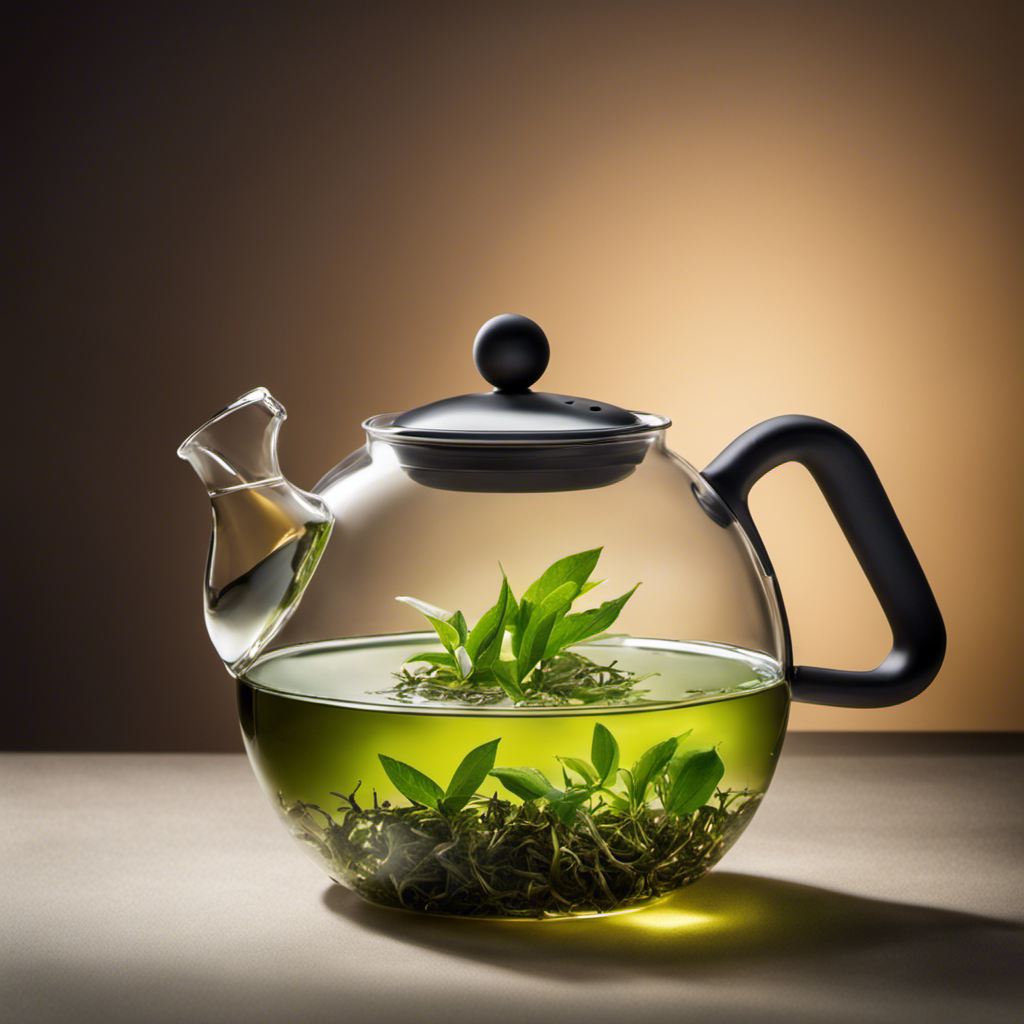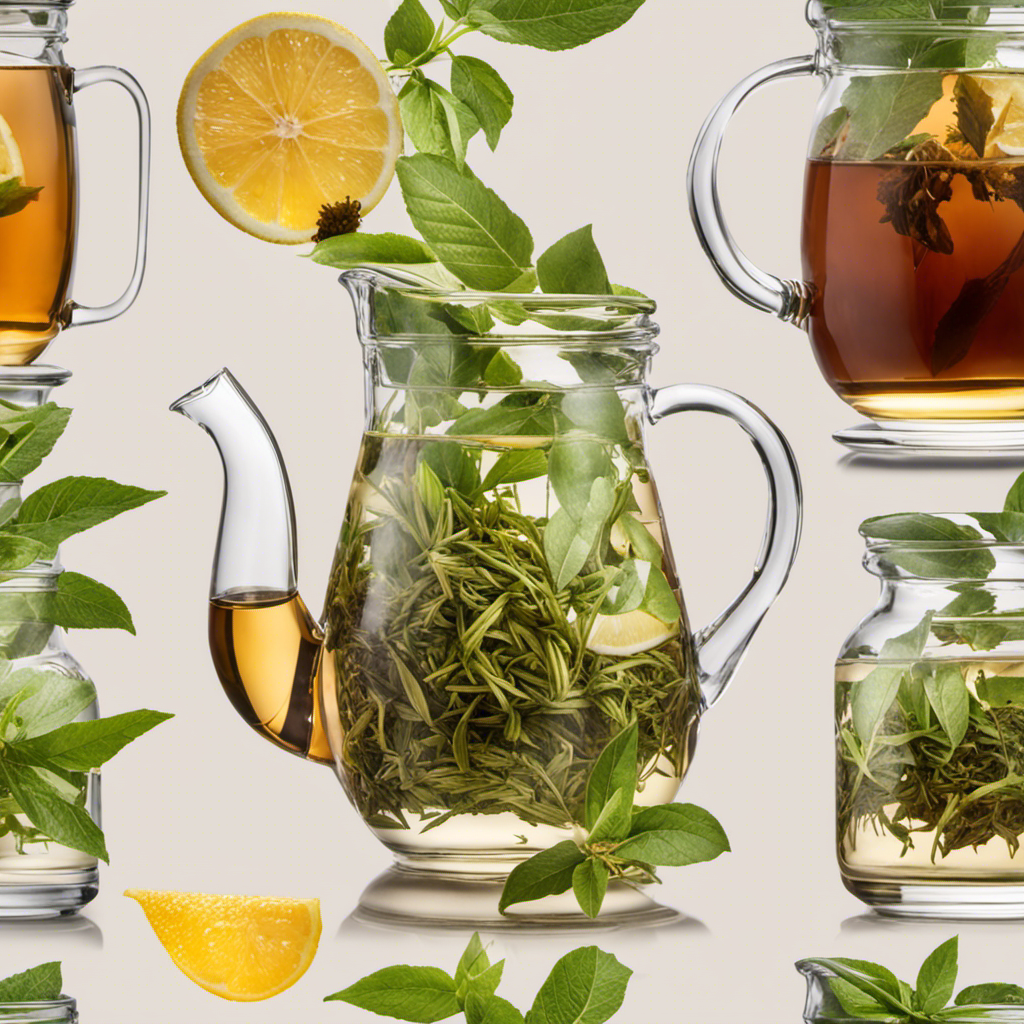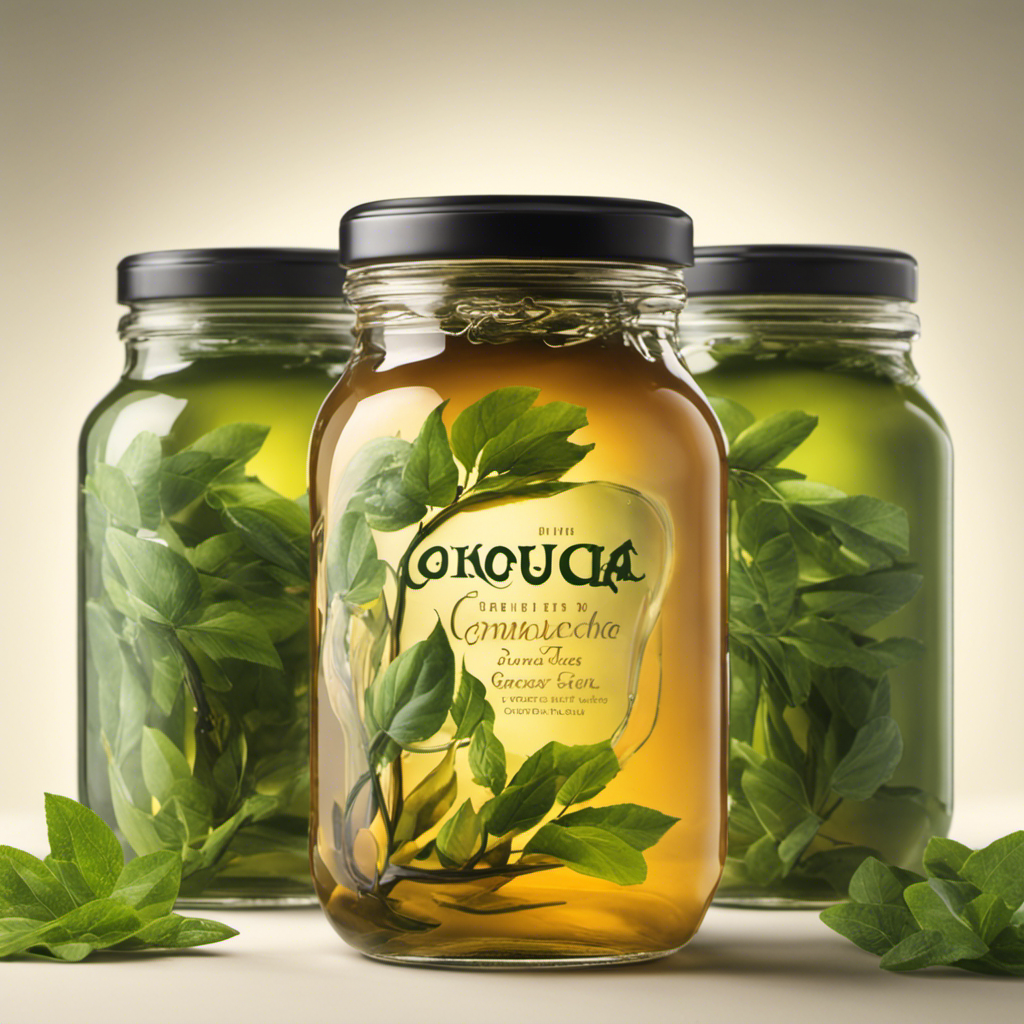Coffee Alternatives And Tea
What Can I Use to Substitute Coffee Filters

As someone who adores coffee, I understand the annoyance of discovering you’re out of coffee filters just as you’re craving your morning brew. However, worry not! There are numerous inventive solutions to ensure you get your caffeine dose.
From paper towels and cheesecloth to cloth napkins and fine mesh sieves, there’s a solution for every situation.
So let’s dive into the world of coffee filter substitutes and discover the perfect match for your brewing needs.
Key Takeaways
- Paper towels and cheesecloth are versatile options for DIY coffee filters.
- Cloth napkins can be used as a substitute for coffee filters.
- Fine mesh sieves are versatile kitchen tools that can be used for straining liquids and separating solids.
- French press and reusable coffee filters are cost-effective and eco-friendly alternatives to traditional filters.
Paper Towels
You can use paper towels as a substitute for coffee filters. Paper towels are a versatile option that can be found in almost every household. They can effectively filter out the coffee grounds and allow you to enjoy a fresh cup of coffee.
When using paper towels as coffee filters, it is important to choose a high-quality and sturdy brand to prevent tearing or disintegration. Simply fold the paper towel into a cone shape and place it in your coffee maker or pour-over device. The paper towel will capture the coffee grounds, resulting in a smooth and flavorful brew.
While paper towels are not as environmentally friendly as reusable filters, they are a convenient and affordable option for DIY coffee filters.
Cheesecloth
When it comes to finding alternatives to coffee filters, one option that often comes to mind is cheesecloth.
Cheesecloth is a versatile and porous fabric that can be used in various culinary applications, including as a substitute for coffee filters. Its fine mesh allows for proper filtration, ensuring that you can still enjoy a smooth and flavorful cup of coffee even without a traditional filter.
Coffee Filter Alternatives
If you’re out of coffee filters, try using a reusable mesh filter as an alternative. Reusable coffee filters are a great option for those who want to reduce waste and save money in the long run. They are typically made from stainless steel or silicone and can be easily cleaned and reused. Here are some benefits of using reusable coffee filters:
| Benefits | Description |
|---|---|
| Environmentally-friendly | Reusable coffee filters help reduce the amount of waste generated. |
| Cost-effective | Instead of constantly buying disposable filters, reusable ones can be used over and over again. |
| Enhanced flavor | Mesh filters allow more oils and flavors to pass through, resulting in a richer and more aromatic cup of coffee. |
| Versatile | Reusable filters can be used with various brewing methods, including pour-over, French press, and cold brew. |
| Easy to clean | Most reusable filters are dishwasher-safe or can be easily rinsed and wiped clean. |
Making the switch to reusable coffee filters not only benefits the environment but also enhances your coffee experience. Give it a try and see the difference for yourself!
Cheesecloth as Substitute
Cheesecloth can be a great alternative for filtering coffee. Its fine mesh weave allows for a smooth and sediment-free cup of joe. Cheesecloth is a versatile fabric that has various uses in the kitchen, and using it as a coffee filter is just one of them.
The benefits of using cheesecloth are numerous. Firstly, it is cost-effective and easily accessible in most grocery or kitchen supply stores. Secondly, it is reusable, making it an eco-friendly option compared to disposable coffee filters. Lastly, cheesecloth allows for more control over the strength of your coffee, as you can adjust the amount of grounds you use.
Transitioning into the subsequent section about cloth napkins, cloth napkins also offer a sustainable and stylish alternative to disposable paper napkins.
Cloth Napkins
You can use cloth napkins as a substitute for coffee filters. Not only are they reusable, but they also make for great DIY filters. Cloth napkins are made of a durable and absorbent material, which makes them ideal for straining coffee grounds. They can be easily folded or cut to fit your coffee maker or French press. Using cloth napkins as filters not only reduces waste, but also allows for a richer and fuller flavor in your coffee. To help you visualize the benefits of using cloth napkins as coffee filters, here’s a handy table comparing cloth napkins to traditional paper filters:
| Cloth Napkins | Paper Filters |
|---|---|
| Reusable | Single-use |
| Durable | Disposable |
| Eco-friendly | Wasteful |
Fine Mesh Sieve
A fine mesh sieve is perfect for straining liquids and separating solids from the mixture. It is a versatile kitchen tool that can be used in various cooking and baking tasks.
The fine mesh strainer has tightly woven wires that effectively filter out smaller particles, leaving behind a smooth and clear liquid. It can be used to strain homemade broths, sauces, and soups, removing any unwanted bits and pieces.
Additionally, a fine mesh sieve can also be a great substitute for a coffee filter holder. Simply place the sieve over a mug or pot, pour the coffee grounds into it, and slowly pour hot water over the grounds. The fine mesh will catch the grounds, resulting in a flavorful and sediment-free cup of coffee.
Muslin Fabric
Muslin fabric is a versatile material that can be used for a variety of purposes in sewing and crafting projects. It is a plain-woven cotton fabric that is lightweight and breathable, making it ideal for garments, curtains, and linings.
One of the advantages of muslin fabric is its affordability, as it is relatively inexpensive compared to other fabrics. Additionally, muslin fabric is easy to work with, as it is easy to cut, sew, and manipulate. It is also durable and can withstand regular washing and wear.
However, there are some drawbacks to using muslin fabric. It tends to shrink when washed, so pre-washing is necessary to avoid any unwanted surprises. Additionally, muslin fabric may not be as luxurious or visually appealing as other fabrics, making it less suitable for certain projects where aesthetics are important.
French Press
The French press is a popular brewing method for coffee enthusiasts who enjoy a rich and full-bodied flavor in their cup. It offers several benefits and requires minimal maintenance. Here are some reasons why you should consider using a French press:
-
Enhanced flavor: The French press allows the coffee grounds to steep directly in hot water, resulting in a robust and flavorful brew.
-
Customizable strength: You have full control over the brewing time and coffee-to-water ratio, allowing you to adjust the strength of your coffee to your liking.
-
Environmentally friendly: Unlike paper filters, a French press doesn’t produce any waste, making it an eco-friendly choice.
-
Cost-effective: Once you invest in a French press, you won’t need to constantly purchase disposable filters, saving you money in the long run.
Using a French press is a fantastic option for coffee lovers who want a full-bodied and customizable brew. However, if you’re looking for an alternative to traditional coffee filters, a reusable coffee filter might be the perfect solution.
Reusable Coffee Filter
If you’re tired of constantly buying disposable filters, a reusable coffee filter could be a cost-effective and eco-friendly option. Not only will it save you money in the long run, but it also helps reduce waste and your carbon footprint.
The benefits of using a reusable coffee filter are numerous. Firstly, it allows for better extraction of flavor and oils from the coffee grounds, resulting in a richer and more flavorful cup of joe. Secondly, it eliminates the need for constantly restocking on paper filters, which can be a hassle and an added expense.
Lastly, cleaning reusable coffee filters is quite simple. Just give it a quick rinse after each use, and occasionally wash it with warm soapy water to remove any stubborn residue.
Frequently Asked Questions
Can I Use a Regular Kitchen Towel as a Substitute for a Coffee Filter?
Yes, I can use a regular kitchen towel as a substitute for a coffee filter. It is similar to using paper towel or cheesecloth as a coffee filter alternative.
Are There Any Alternatives to Using a French Press as a Coffee Filter?
There are a couple of alternatives to using a French press as a coffee filter. One option is using a metal mesh sieve, which can effectively strain the coffee grounds. Another option is using paper towels, which can act as a substitute for coffee filters.
Can I Use a Handkerchief as a Coffee Filter Substitute?
Yes, a handkerchief can be used as a coffee filter substitute. It is similar to using a paper towel, but be aware that the texture may affect the taste. Another alternative is using cheesecloth, which provides a finer filter for a smoother cup of coffee.
What Are Some Creative Alternatives to Using Traditional Coffee Filters?
When it comes to making coffee, I’ve found some creative alternatives to traditional filters. DIY coffee filters at home can be made without traditional materials, like using socks or paper towels. Let me share some unique options!
Can I Use a Tea Strainer or Tea Bag as a Makeshift Coffee Filter?
Yes, you can use a tea strainer or a tea bag as a makeshift coffee filter. However, if you don’t have those, using a mesh strainer or a paper towel can also work effectively.
Conclusion
In conclusion, there are various alternatives to coffee filters that can be used to brew a delicious cup of joe.
From paper towels and cheesecloth to cloth napkins and fine mesh sieves, each option offers its own unique benefits and drawbacks.
For a more sustainable choice, one can opt for a French press or reusable coffee filter.
Remember, just like a skilled magician who can pull a rabbit out of a hat, these substitutes can work their magic and deliver a satisfying coffee experience.
So go ahead, explore the world of alternatives, and enjoy your perfect cup of coffee!
Noah, the Editor-in-Chief at Cappuccino Oracle, plays a pivotal role in shaping the voice and vision of our renowned platform. With an unwavering passion for coffee, coffee alternatives, and tea, Noah leads Cappuccino Oracle towards new horizons in the realm of coffee journalism.
Beyond his professional responsibilities, Noah serves as a mentor and guiding force for his team. His dedication to journalistic excellence and genuine love for coffee, coffee alternatives, and tea continue to inspire and motivate the Cappuccino Oracle family. In the ever-evolving world of these beverages, Noah’s leadership ensures that our platform remains at the forefront, delivering enlightening and enjoyable content to our readers worldwide.
Turmeric Tea
How Long to Steep Green Tea for Kombucha

As someone who loves tea, I have found that the key to making the best kombucha is mastering the process of brewing green tea.
The right amount of time can make all the difference in unlocking the vibrant flavors and health benefits.
Join me on this journey as we delve into the world of steeping, exploring the factors that influence the process and uncovering the recommended steeping time for green tea in kombucha.
Get ready to sip your way to kombucha perfection!
Key Takeaways
- Steeping time is crucial for unlocking optimal flavors in green tea for kombucha.
- Different types of green tea require different steeping times.
- Steeping green tea in kombucha for 3-5 minutes is generally recommended to release flavors and antioxidants without excessive bitterness.
- Adjusting steeping time allows customization of the tea to personal taste, ranging from mild and subtle to bold and robust flavor profiles.
Understanding the Importance of Steeping Time
To achieve the best flavor and health benefits, you should steep your green tea for the recommended amount of time.
Steeping time is crucial when it comes to exploring optimal flavors in your tea. Different types of green tea require different steeping times to release their full potential.
Experimenting with different teas can be a fun and exciting way to discover your personal preferences. Some teas may need only a couple of minutes to steep, while others may require a longer steeping time.
It is important to follow the instructions provided by the tea manufacturer or use a general guideline for steeping time, usually ranging from 1 to 3 minutes.
Understanding the importance of steeping time will allow you to fully enjoy the flavors and health benefits of green tea.
Now, let’s delve into the factors that influence steeping time.
Factors That Influence Steeping Time
Factors such as water temperature, tea quality, and personal preference can affect how long you should let the leaves steep. The brewing techniques used, along with these factors, play a crucial role in flavor extraction.
Water temperature is key, as different types of tea require specific temperatures to bring out their optimal flavors. For green tea, a lower temperature of around 175°F is recommended to prevent bitterness.
Additionally, the quality of the tea leaves can impact the steeping time. Higher quality leaves often require less time to extract their flavors fully.
Lastly, personal preference plays a significant role. Some individuals may prefer a stronger, more robust flavor and may choose to steep the tea for a longer duration.
Now, let’s dive into the recommended steeping time for green tea in kombucha.
Recommended Steeping Time for Green Tea in Kombucha
The ideal amount of time to let the leaves infuse in this fermented beverage can vary depending on personal taste preferences and the desired strength of flavor. When it comes to green tea in kombucha, the recommended steeping time is generally around 3-5 minutes. This allows the tea to release its flavors and antioxidants without becoming too bitter. Green tea is a popular choice for kombucha due to its numerous health benefits. It is rich in antioxidants, which help to reduce inflammation and boost the immune system. Additionally, green tea contains a compound called EGCG, which has been shown to have anti-cancer properties. By steeping green tea for the recommended amount of time, you can ensure that your kombucha has a balanced and refreshing taste, while also reaping the benefits of this powerful tea.
| Steeping Time | Flavor Profile |
|---|---|
| 3 minutes | Light and delicate |
| 4 minutes | Balanced and smooth |
| 5 minutes | Robust and full-bodied |
Oversteeping Vs. Understeeping: Finding the Sweet Spot
Finding the perfect balance of flavor when steeping your tea is crucial. Oversteeping or understeeping can greatly impact the taste of your beverage.
Oversteeping can lead to a bitter and astringent flavor that overwhelms the delicate notes of the tea. This happens because the longer the tea leaves steep, the more tannins are released, resulting in a harsh taste.
On the other hand, understeeping can leave your tea tasting weak and lacking in depth. The flavors and aromas may not fully develop, leaving you with a bland and unsatisfying cup.
It’s important to follow the recommended steeping times for different types of tea to achieve the desired flavor profile. By finding the sweet spot, you can ensure a perfectly balanced and enjoyable tea experience.
Adjusting Steeping Time for Personal Preference
To customize your tea to your taste, experiment with adjusting the steeping time to find the perfect balance of flavor. When it comes to green tea for kombucha, the steeping time can greatly impact the taste and quality of your brew. Adjusting the steeping time allows you to control the strength and intensity of the flavor, whether you prefer a mild and subtle taste or a bolder and more robust flavor profile. Experimenting with different steeping times is the key to finding your preferred taste. To help you get started, here is a table outlining the general guidelines for steeping green tea for kombucha:
| Steeping Time | Flavor Profile |
|---|---|
| 1-2 minutes | Light and delicate |
| 2-3 minutes | Balanced and smooth |
| 3-4 minutes | Full-bodied and bold |
| 4-5 minutes | Strong and robust |
| 5+ minutes | Bitter and astringent |
Conclusion
In conclusion, steeping green tea for kombucha is a delicate art that requires precision and attention to detail. By understanding the importance of steeping time and the factors that influence it, you can achieve the perfect balance of flavors in your brew.
Whether it’s the refreshing taste of a lightly steeped tea or the boldness of a longer steep, finding the sweet spot is key. So, experiment with different steeping times and adjust to your personal preference, creating a symphony of flavors that dances on your taste buds.
Noah, the Editor-in-Chief at Cappuccino Oracle, plays a pivotal role in shaping the voice and vision of our renowned platform. With an unwavering passion for coffee, coffee alternatives, and tea, Noah leads Cappuccino Oracle towards new horizons in the realm of coffee journalism.
Beyond his professional responsibilities, Noah serves as a mentor and guiding force for his team. His dedication to journalistic excellence and genuine love for coffee, coffee alternatives, and tea continue to inspire and motivate the Cappuccino Oracle family. In the ever-evolving world of these beverages, Noah’s leadership ensures that our platform remains at the forefront, delivering enlightening and enjoyable content to our readers worldwide.
Turmeric Tea
What Is the Benefits of Kombucha Tea

Were you aware that kombucha tea has been enjoyed for centuries because of its numerous health advantages?
In fact, studies have shown that this fermented beverage can improve digestion, boost the immune system, aid in weight management, and even support detoxification.
As someone who values holistic wellness, I am excited to share with you the evidence-based benefits of kombucha tea.
So, grab a glass and join me on this journey to discover the incredible advantages of this ancient elixir.
Key Takeaways
- Kombucha tea improves digestion.
- It boosts the immune system.
- Kombucha tea aids in weight management.
- It supports detoxification.
Health Benefits of Kombucha Tea
You’ll love the health benefits of kombucha tea, such as improved digestion and increased immune function.
But did you know that kombucha tea can also have positive effects on your skin health and mental wellness?
Kombucha tea contains beneficial acids, vitamins, and antioxidants that can promote a healthy complexion and reduce the signs of aging. It can also help improve the overall texture and tone of your skin.
As for mental wellness, kombucha tea is rich in B vitamins, which are essential for brain health and can help improve mood and reduce stress. Additionally, the probiotics in kombucha tea can support a healthy gut-brain connection, which is important for mental well-being.
With its numerous health benefits, kombucha tea is truly a holistic beverage that can enhance not only your physical health but also your skin and mental well-being.
Now, let’s explore how kombucha tea can boost digestive health even further.
Boosting Digestive Health With Kombucha Tea
Boosting digestive health can be achieved with the consumption of kombucha tea. Kombucha is a fermented tea that is rich in probiotics, which are beneficial bacteria that support gut health. These probiotics help to balance the bacteria in your digestive system, promoting optimal digestion and nutrient absorption.
The live cultures in kombucha tea can also help to improve the function of your gut by reducing inflammation and enhancing the production of enzymes that aid in the breakdown of food. Additionally, kombucha tea contains organic acids that can support the growth of good bacteria in your gut and inhibit the growth of harmful bacteria.
Kombucha Tea and Its Impact on Immune System
Drinking kombucha can improve your immune system by supporting the growth of beneficial bacteria in the gut. The immune system plays a crucial role in protecting our bodies from infections and diseases. Research suggests that the gut microbiota, which consists of trillions of bacteria, fungi, and other microbes, plays a significant role in immune system support.
Kombucha, a fermented tea, contains probiotics that can help enhance the diversity and balance of the gut microbiota. This can lead to a stronger immune response and potentially reduce the risk of allergies. Studies have shown that probiotics found in kombucha can modulate the immune system and help alleviate symptoms of allergies.
So, incorporating kombucha into your diet may have beneficial effects on your immune system and overall health.
Speaking of health benefits, let’s explore how kombucha tea can aid in weight management.
Weight Management and Kombucha Tea
Incorporating kombucha into your diet can help with weight management by promoting a healthy metabolism and supporting a balanced gut microbiota. Here are four ways that kombucha tea can benefit your weight management journey:
-
Boosts metabolism: Kombucha contains organic acids and enzymes that can help increase your metabolic rate, allowing your body to burn calories more efficiently.
-
Supports gut health: The probiotics found in kombucha can help restore and maintain a healthy balance of bacteria in your gut. This is important for weight management as an imbalanced gut microbiota has been linked to weight gain and obesity.
-
Reduces cravings: Kombucha can help curb your cravings for sugary and unhealthy foods. Its tangy and slightly sweet taste can satisfy your taste buds and prevent you from reaching for unhealthy snacks.
-
Provides hydration: Staying hydrated is essential for weight management, and kombucha can be a refreshing and hydrating beverage option.
The Role of Kombucha Tea in Detoxification
Detoxification can be supported by incorporating kombucha into your diet, as it aids in promoting a healthy gut microbiota. Kombucha tea is known for its numerous health benefits, including its ability to support liver function. The liver plays a vital role in detoxification, as it helps remove toxins from the body.
Kombucha tea contains beneficial acids and antioxidants that can help protect the liver and support its detoxification processes. Additionally, kombucha tea has been found to have positive effects on skin health. The antioxidants and probiotics present in kombucha can help improve skin elasticity and reduce the appearance of wrinkles.
Incorporating kombucha tea into your daily routine can be a great way to support your body’s natural detoxification processes and promote overall health and well-being.
Conclusion
In conclusion, the benefits of kombucha tea are numerous and can greatly contribute to our overall health and well-being.
With its ability to boost digestive health, strengthen the immune system, aid in weight management, and support detoxification, kombucha tea is a powerful elixir.
One interesting statistic to highlight is that kombucha tea contains probiotics, which are beneficial bacteria that can improve gut health. In fact, a single serving of kombucha tea can contain billions of these probiotics, promoting a healthy digestive system.
Incorporating kombucha tea into our daily routine can have a profound impact on our health.
Noah, the Editor-in-Chief at Cappuccino Oracle, plays a pivotal role in shaping the voice and vision of our renowned platform. With an unwavering passion for coffee, coffee alternatives, and tea, Noah leads Cappuccino Oracle towards new horizons in the realm of coffee journalism.
Beyond his professional responsibilities, Noah serves as a mentor and guiding force for his team. His dedication to journalistic excellence and genuine love for coffee, coffee alternatives, and tea continue to inspire and motivate the Cappuccino Oracle family. In the ever-evolving world of these beverages, Noah’s leadership ensures that our platform remains at the forefront, delivering enlightening and enjoyable content to our readers worldwide.
Turmeric Tea
How Much Tea per Quart Kombucha

As an enthusiastic kombucha maker, I have always been intrigued by the process of crafting the ideal brew. Just like a conductor guiding an orchestra, the quantity of tea we incorporate in our kombucha is essential in attaining that perfect blend of flavors.
In this article, we’ll explore the ideal tea-to-water ratio for optimal kombucha taste, as well as how different tea varieties can influence the fermentation process. Get ready to dive into the world of tea and discover just how much tea should go into your quart of kombucha.
Key Takeaways
- Black tea and green tea are commonly used as the base for kombucha due to their high caffeine content.
- Herbal teas like hibiscus, chamomile, and peppermint can be used for a caffeine-free option or to add unique flavors.
- The ideal tea-to-water ratio for optimal kombucha flavor is one tablespoon of loose tea leaves per quart of water.
- Adjusting the amount of loose tea leaves used can control the intensity and strength of the kombucha flavor.
Types of Tea for Brewing Kombucha
There’s a wide variety of tea options for brewing kombucha. When it comes to choosing the right tea, it’s important to consider both the caffeine content and the flavor variations that herbal teas can offer.
Teas with high caffeine content, such as black tea or green tea, are commonly used as the base for kombucha. The caffeine helps to provide a vital energy boost during fermentation. However, if you prefer a caffeine-free option or want to experiment with different flavors, herbal teas can be a great choice. Popular herbal teas for brewing kombucha include hibiscus, chamomile, and peppermint. These teas can add a unique twist to your kombucha, creating a delicious and refreshing beverage.
Now that we’ve explored the different types of tea, let’s move on to discussing the tea-to-water ratio for optimal kombucha flavor.
Tea-to-Water Ratio for Optimal Kombucha Flavor
For the best flavor, it’s important to use the right ratio of tea to water when making kombucha. The ideal ratio is one tablespoon of loose tea leaves per quart of water. This ensures that the tea flavor is not too overpowering or diluted.
When it comes to brewing time, different types of tea require varying steeping times in kombucha. Black tea, which is commonly used in kombucha, should be steeped for 15 minutes. Green tea, on the other hand, only needs 10 minutes. Herbal teas, such as chamomile or mint, should be steeped for 5 minutes to retain their delicate flavors.
Using flavored teas in kombucha fermentation can add interesting and unique flavors to your brew. However, it’s important to note that some flavored teas may contain additives or oils that can negatively impact the fermentation process. It’s best to opt for natural flavored teas or add flavorings during the second fermentation stage.
Adjusting Tea Amounts for Stronger or Weaker Kombucha
To make your kombucha stronger or weaker, you can adjust the amount of loose tea leaves used in the brewing process. By varying the quantity of tea, you can control the intensity of the flavor and the overall strength of your kombucha.
When it comes to tea brewing techniques for a more robust kombucha flavor, using more tea leaves in relation to the amount of water will result in a stronger brew. Conversely, reducing the amount of tea will yield a milder taste.
Experimenting with different tea blends is another way to create unique kombucha taste profiles. Each tea variety brings its own distinct flavors and characteristics to the brew.
In the subsequent section, we will discuss how different tea varieties affect kombucha fermentation, further exploring the relationship between tea and the fermentation process.
How Different Tea Varieties Affect Kombucha Fermentation
Try experimenting with various tea varieties to see how they impact the fermentation process of your kombucha. Different types of tea can have a significant impact on the flavor and overall quality of your brew. Here are a few key points to consider:
-
Tea quality and its impact on kombucha fermentation:
-
High-quality loose-leaf teas often yield better results than tea bags.
-
Organic teas are preferable to avoid any potential chemical residues.
-
Different tea regions and cultivars can result in unique flavor profiles.
-
Exploring the role of caffeine in kombucha fermentation:
-
Caffeine acts as a source of food for the kombucha culture.
-
Teas with higher caffeine content may result in faster fermentation.
-
However, excessive caffeine can potentially harm the culture.
Factors to Consider When Determining Tea Quantity for Kombucha
When determining the quantity of tea for your kombucha, consider using a ratio of 1 cup of loose-leaf tea for every gallon of water. This ratio ensures a well-balanced flavor and optimal fermentation.
There are several factors to consider when determining the tea quantity for your kombucha. The first factor is the strength of the tea. If you prefer a stronger brew, you may want to increase the amount of tea used.
Another factor to consider is the brewing time. The longer the tea is brewed, the stronger the flavor will be.
Additionally, the type of tea used can affect the fermentation process. It is important to use organic tea as it ensures that no unwanted chemicals or pesticides are present, which can hinder the fermentation process. Using organic tea also enhances the overall taste and quality of your kombucha.
Frequently Asked Questions
Can I Use Herbal Tea to Brew Kombucha?
Yes, herbal tea can be used to brew kombucha. It adds unique flavors and benefits to the final product. However, it’s important to note that some herbal teas may not provide enough nutrients for the SCOBY, so a combination with black or green tea is recommended.
What Is the Ideal Brewing Time for Black Tea Kombucha?
The ideal brewing time for black tea kombucha depends on personal preference. Generally, 7-10 days at room temperature is recommended. Caffeine in black tea provides nutrients for the SCOBY during fermentation.
Can I Use Loose Leaf Tea Instead of Tea Bags for Making Kombucha?
Using loose leaf tea instead of tea bags for making kombucha can result in a richer and more complex flavor profile. However, there are potential drawbacks such as increased sediment and the need for straining.
How Does Using Green Tea Affect the Fermentation Process of Kombucha?
Using green tea in kombucha fermentation provides additional health benefits due to its high antioxidant content. However, other tea options like black or oolong can also be used depending on personal preference and desired flavor profile.
Are There Any Health Benefits Associated With Using Specific Types of Tea for Brewing Kombucha?
There are various health benefits associated with using different types of tea for brewing kombucha. Each tea imparts its unique flavor profile, which can range from floral to earthy or even fruity.
Conclusion
In conclusion, determining the right amount of tea for a quart of kombucha is crucial for achieving the perfect flavor. By following the recommended tea-to-water ratio, you can ensure optimal taste and fermentation.
However, it’s important to note that different tea varieties can affect the fermentation process differently, so adjustments may be needed.
Just like a skilled conductor harmonizes an orchestra, finding the right balance of tea in your kombucha is like creating a symphony of flavors that will leave your taste buds dancing with delight.
Arf, an author and an innovative enthusiast of coffee, coffee alternatives, and tea, plays a crucial role as a contributor to the esteemed Cappuccino Oracle platform. Renowned for his curiosity and passion for these captivating beverages, Arf has carved out a unique space for himself in the world of exploration and writing. He realized that coffee, coffee alternatives, and tea are not mere drinks to keep one awake, but universes of flavors and stories waiting to be explored.
Arf’s articles for Cappuccino Oracle blend meticulous research with personal experiences, providing readers with an in-depth understanding of various types of coffee, coffee alternatives, and tea, along with their unique characteristics, cultures, and histories. His honest reviews and engaging narratives guide readers on their own journeys, helping them discover their preferences and find their perfect brew.
-

 Americano4 weeks ago
Americano4 weeks agoHow to Make Americano With Moka Pot
-

 Americano2 weeks ago
Americano2 weeks agoHow to Make Korean Iced Americano
-

 Americano4 weeks ago
Americano4 weeks agoHow to Make Americano With Bialetti
-

 Americano4 weeks ago
Americano4 weeks agoHow to Make Dutch Bros Americano
-

 Americano1 week ago
Americano1 week agoHow to Make an Iced Americano With Nespresso
-

 Americano3 weeks ago
Americano3 weeks agoHow Many Shots of Espresso for 16 Oz Americano
-

 Americano4 weeks ago
Americano4 weeks agoHow to Make a Hazelnut Americano
-

 Turmeric Tea2 weeks ago
Turmeric Tea2 weeks agoTurmeric Saffron Tea














